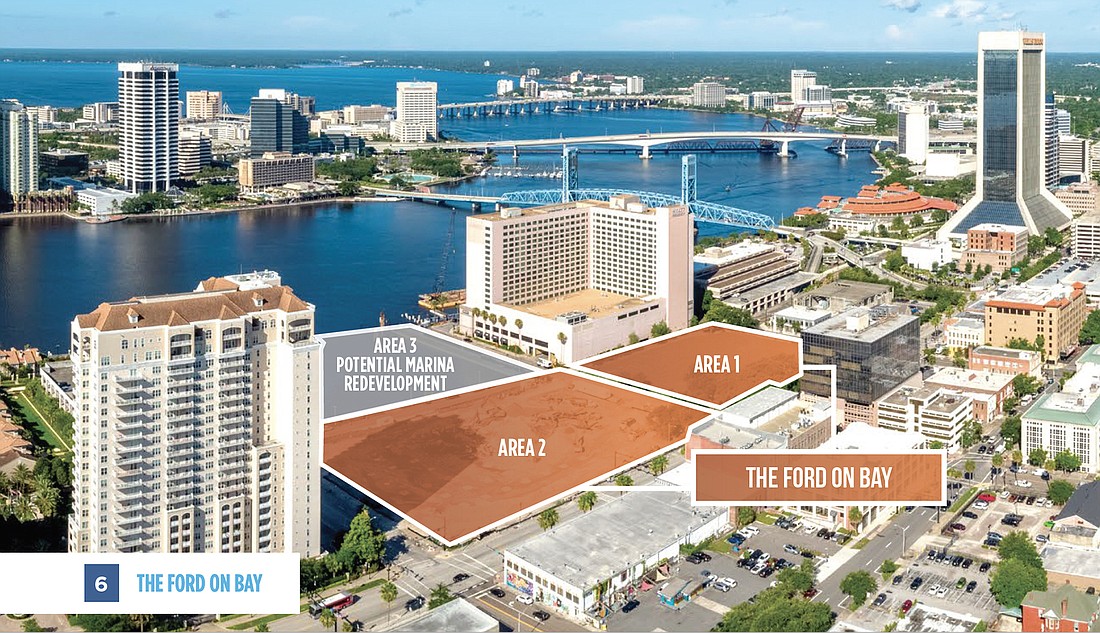
When the Downtown Investment Authority begins looking for developers for the former Duval County Courthouse and City Hall sites — now branded The Ford on Bay — officials expect bids from top-tier national developers, and possibly international investors.
The DIA will issue a request for proposals Monday to develop the city-owned property. Bids are due Jan. 21.
CBRE Jacksonville, the real estate firm chosen by DIA to brand and market The Ford on Bay, has sent email blasts that include an executive summary calling the site a “rare and unique mixed-use development opportunity on ±8.38 acres of high visible land in downtown Jacksonville.”
Cliff Taylor and Joe Ayers, CBRE’s co-leads for North Florida multifamily investment sales, told the DIA board in September they will market the city-owned property “far and wide.”
“There will be a conversation with a large number of groups of high caliber that have never developed here in the past,” Taylor told the DIA on Sept. 18.
Two of the parcels are vacant green space at 220 and 330 E. Bay St. and the third is submerged land under the St. Johns River.
DIA officials say the development will be mixed-use and could include office, open space and a hotel.
The DIA said 80% of East Bay Street buildings’ frontage must be retail. A public-private marina is envisioned for the water parcel.
The board approved the project’s development terms, bid scoring criteria and CBRE’s marketing plan at the Sept. 18 meeting.
Ayers said CBRE will post The Ford on Bay project on a database accessible by active developers across the U.S.
“A site of this caliber, to a point, needs to be in front of groups that have never developed here before. We all believe sitting here, jointly, that Jacksonville is growing, has a lot to offer and we’re seeing growth for real estate development projects at a level that justifies a new tier of construction quality and design,” Taylor said.
National interest
There’s a precedent for attracting national interest to develop the property.
The first time the site was put on the market in August 2018, the DIA chose a proposal by Dallas-based international developer Jacobs Engineering Group, which proposed a $598 million convention center, hotel and retail complex.
The company has more than 80,000 employees globally, according to its website, and reports $15 billion in annual revenue.
Bids also came in from Jacksonville-based Rimrock Devlin DeBartolo Development and Preston Hollow of Dallas. Rimrock Devlin DeBartolo is a partner with Jacksonville Jaguars owner Shad Khan’s proposed Shipyards project.
The project was halted after Mayor Lenny Curry questioned the city’s estimated $1.2 billion financial liability over the lifetime of the convention complex. Also, Khan has proposed building a convention center at Metropolitan Park as part of his $2.5 billion vision for the Downtown Northbank.
“Prior to commencing work on anything related to this site, we have been fielding numerous conversations with very prolific developers who are paying close attention to the (office) rental rate growth here in Jacksonville and Northeast Florida,” Ayers said.
In 2018, the average lease rate for Downtown office space was $21.54 per square foot, according to Downtown Vision Inc.’s 2018-19 State of Downtown Report. That’s up from $20.23 in 2017.
The Ford on Bay proposals could include high-rise Class A office space. Christian Harden, managing partner of real estate brokerage NAI Hallmark, says capital investment in Downtown is favoring midrise projects.
“To go and build a high-rise in Jacksonville, to go replicate a building like the (42-story) Bank of America Tower, rents would need to be $40 per (square) foot for full service. We don’t have as much demand quite yet, but we’re trending to that,” Harden said.
What could generate office investment is residential and retail development, which are part of The Ford on Bay bidding criteria.
“If you have residential Downtown, then you’ll have retail Downtown with restaurants and stores because more people are populating those locations during the weekends, which affords a seven-day-per-week rent versus a five-day-per-week rent,” Harden said. “It’s a snowball effect. The more amenities there are Downtown, the more desirable it will be to be an office user Downtown.”
Financing Downtown
While The Ford on Bay likely will entice U.S. developers, international capital investment could play a role in financing the project.
Matt Brockelman is a lobbyist with The Southern Group.
He works with real estate developers and with public-private partnerships on job creation, nonprofit advocacy and local government legislative initiatives.
Brockelman said the Jacksonville market has grabbed the attention of international capital investors for projects like The Ford on Bay, but not all Downtown projects are as large.
Brockelman said developers ask how to bundle their projects to make the return on investment worth the attention of international financiers.
“As investors look to park their funds in the marketplace, the individual interest may be sound but their return on investment would not be as high,” Brockelman said.
For larger domestic and international capital investment firms, a development needs to reach a dollar-volume threshold that varies.
Brockelman said a developer could bundle projects in their Downtown portfolio and offer a multiproject opportunity that would give investors a higher rate of return than would a single project.
For companies and real estate investors, Brockelman said that’s better than investing capital in “five or 10 different marketplaces cobbled together.”
Brockelman sees it as a workable model for the city’s independent authorities like the DIA and the Jacksonville Transportation Authority. Both are trying to sell underused city-owned property Downtown.
He said creating a portfolio of city-owned assets that could be financed as a package would bring more capital investment from outside Jacksonville.
“That would hold the interest of the New York City and West Coast investors,” Brockelman said.